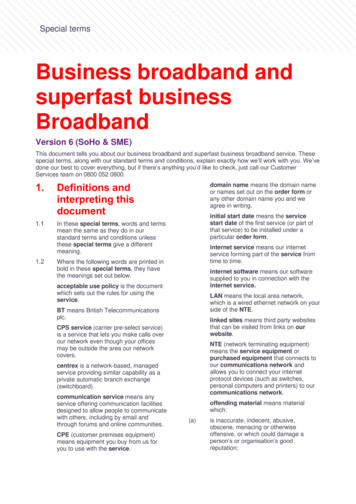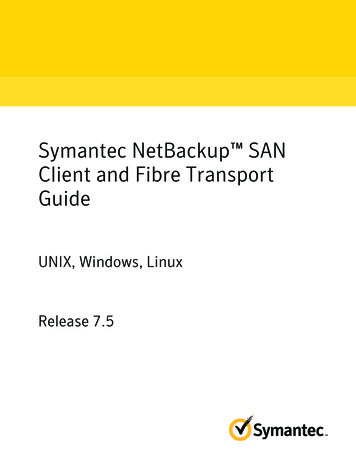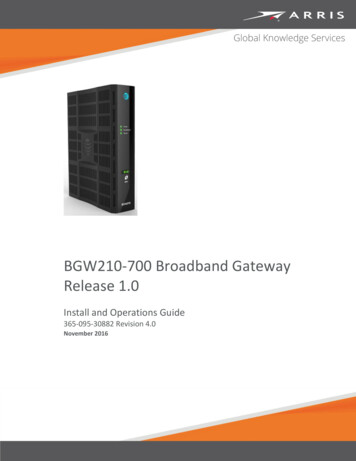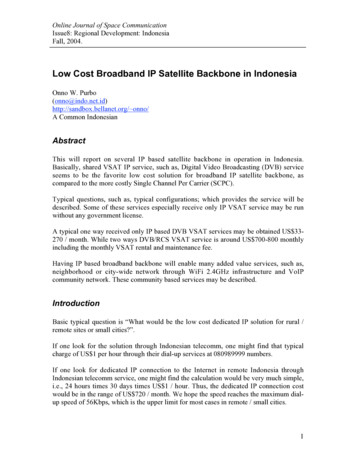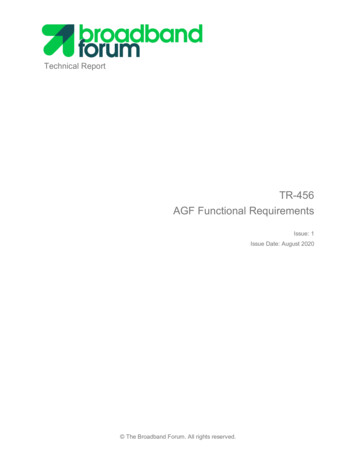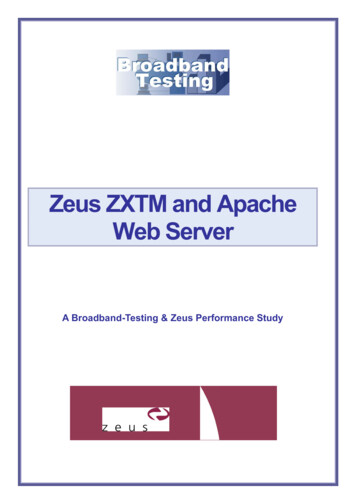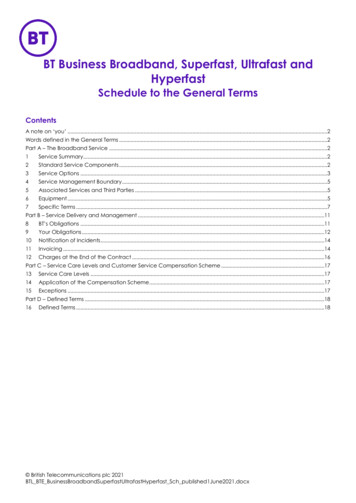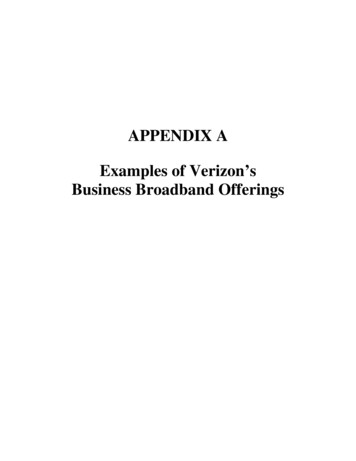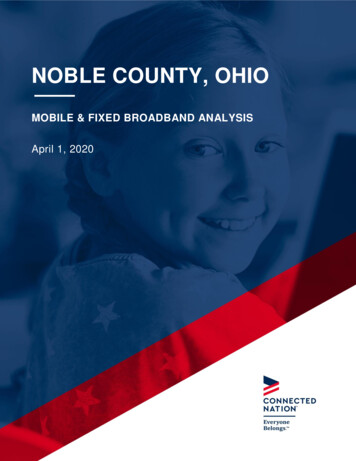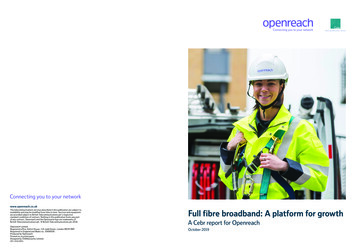
Transcription
Connecting you to your networkMaking Business SenseConnecting you to your networkwww.openreach.co.ukThe telecommunications services described in this publication are subject toavailability and may be modified from time to time. Services and equipmentare provided subject to British Telecommunications plc’s respectivestandard conditions of contract. Nothing in this publication forms any partof any contract. Openreach and the Openreach logo are trademarks ofBritish Telecommunications plc. British Telecommunications plc 2018.Openreach LimitedRegistered office: Kelvin House, 123 Judd Street, London WCIH 9NP.Registered in England and Wales no. 10690039.Produced by Openreach.Printed on recycled paper.Designed by Chilliblossoms Limited.OP1.1910.0093.Full fibre broadband: A platform for growthA Cebr report for OpenreachOctober 2019
AboutCebrOpenreachFor over 25 years the Centre for Economics and BusinessResearch (Cebr) has supplied independent economicforecasting and analysis to hundreds of private firms andpublic organisations, combining robust economic analysiswith a solid understanding of how to present insights ina meaningful, clear way. Cebr delivers award-winningforecasts of the UK and global economies and has advisedseveral government departments as well as FTSE andmulti-national firms on a range of topics. Cebr regularlyuses innovative methodologies to quantify the economiccontribution of new technologies and other aspects of theeconomy that are difficult to quantify.Openreach Limited is the UK’s digital network business.Our recent work includes economic impact assessmentsfor a range of proposed or existing fiscal and other policymeasures, sectoral economic impact studies, and broadertransport and housing infrastructure projects. We haveworked on many and varied themes, including: Crossrail 2 Economic Impact Report – producinga comprehensive evidence base on the economicbenefits of a major rail scheme (TfL, to inform DfT’sadvice to ministers);We’re 33,000 people, working in every community toconnect homes, schools, shops, banks, hospitals, libraries,mobile phone masts, broadcasters, governments andbusinesses – large and small – to the world.Our mission is to build the best possible network, with thehighest quality service, making sure that everyone in theUK can be connected. We work on behalf of more than620 communications providers like Sky, TalkTalk, Vodafone,BT and Zen, and our fibre broadband network is the biggestin the UK, passing more than 27.6m UK premisesOver the last decade we’ve invested more than 13 billion into our network and, at more than 173 millionkilometres – it’s now long enough to wrap around theworld 4,314 times.Today we’re building an even faster, more reliable andfuture-proof broadband network which will be the UK’sdigital platform for decades to come. Housing policy requirements to unlock transformationalgrowth in the Northern Powerhouse (Homes for theNorth, aimed at influencing MHCLG); The economic impact of the arts and culture sectorin England (Arts Council/DCMS); Maximum stakes for Fixed Odds Betting Terminals(BACTA). This provided evidence to supported therecent legislative changes made in this sector; Alcohol minimum unit pricing (Molson Coors); The impact of a Digital Services Tax; The effect of alcohol duties on the UK economy(Scotch Whisky Association); Restrictions on placement of unhealthy food in theretail sector (General Mills); The economic impacts of the UK maritime sector(Maritime UK); Transitional costs of renationalising the prisonprobation service (Probation Service, aimed at DoJ).DisclaimerWhilst every effort has been made to ensure the accuracy of the material in thisdocument, neither Centre for Economics and Business Research Ltd nor the report’sauthors will be liable for any loss or damages incurred through the use of the report.Authorship and acknowledgementsThis report has been produced by Cebr, an independent economics and businessresearch consultancy established in 1992. The views expressed herein are thoseof the authors only and are based upon independent research by them.The report does not necessarily reflect the views of Openreach.London, October 2019A Cebr report for Openreach1
Openreach ForewordContentsFull fibre is the UK’s digital future. It will provide people with morereliable, faster, and future-proof broadband.Openreach Foreword03Executive Summary04Key findings08Introduction11And I’m convinced that the technology itenables will become the backbone of ournational economy, supporting every aspectof our daily lives for decades to come.Why full fibre is importantHow broadband is deliveredThe UK’s digital infrastructure in contextClive SelleyCEO OpenreachInfrastructure investment and uncertaintyOverarching economic impacts18It highlights how working patterns willshift, where people live could change, withbenefits that could be realised in everyregion of the UK.30At Openreach, we’re excited to be leadingthe way in making this vision a reality.We have the ambition to connect thewhole country to full fibre and we’vealready reached more than 1.8 millionhomes and businesses. Our engineersare building this new network to morethan 22,000 premises each week –that’s a home every 28 seconds – andwe’re continuing to increase the sizeand scale of our deployment. We’re ontrack to reach four million premises byMarch 2021 and, with the right support,I believe we can continue to scale-up ourbuild to three million premises a year.Key findingsIntroductionSelection of labour productivity assumptionsAnalytical approachTake-up assumptionsIncorporating workforce impactsModelled outputsSpatial impactsKey findingsIntroductionRebalancing the economyRegional rebalancingInputs, outputs, and parametersModel area archetypesModel scenarios and resultsIncreased output from new home workersEnvironmental benefits of increased working from homeWorkforce impacts46Key findingsIntroductionEnabling carers to work remotelyEnabling an ageing population to work later in lifeBringing forward parents’ return to workSummary of workforce impactsWider Benefits and ImplicationsThis report highlights the benefits thatfull fibre will bring – billions of poundsin productivity gains, jobs createdthroughout the country and people betterable to live and work in rural communities.54Wider social benefits of full fibreIt is crucial that no area of the UK is leftbehind. Openreach is particularly committedto improving the quality of rural connectivityand we’re the only digital infrastructureprovider doing that at any significant scale.This report highlights how full fibre offersone of the quickest, most effective ways toboost productivity – not only in London andthe South East – but across the country.Whether it’s enabling people to work fromhome, to relocate or return to the workforce,rural economies have the potential tobenefit enormously.Full fibre connectivity is essential tofuture-proofing our economy. It will ensurethe UK can be competitive on the worldstage, especially important as we leavethe European Union. And it will unlockthe next generation of technologicalinnovation, allowing our digitaleconomy to continue flourishing.Building the new network across the UKwon’t be quick or easy. It requires a physicalbuild to more than 30 million front doors,thousands of skilled engineers and billionsof pounds of investment. Without the rightpolicies and regulations, there’s a real riskwe’ll fall behind other nations and fail tounlock the benefits that better, more reliablebroadband can bring to the whole country.The National Infrastructure Commission(NIC) estimated that the total level ofinvestment required for nationwidefull fibre will be in the region of 33 billion. With the right policies andregulations in place, the private sectorwill be responsible for the vast majority ofthat investment. That means comparativelylow levels of public subsidy will be required.And in contrast to other major infrastructureprojects such as Heathrow and HS2, there iscross-party support for acceleratingfull fibre deployment.Deploying full fibre offers benefits as webuild, not just when we’ve finished, andfor every community in the UK. That’swhy today we’ve also published a blueprintsetting out what’s needed to underpin anacceleration in our deployment. It highlightssome of the changes that will be required,working with industry, Government andOfcom, and sets out our role at Openreachin enabling this to happen.This report highlights the prize for thewhole country if Government and Ofcomcan help clear the barriers to a nationwidefull fibre rollout. We’re proud to beleading the charge and playing our partin such a transformational change – forcommunities, consumers and businessesacross the country.Wider policy implicationsConclusions59Annex: Analytical framework60A Cebr report for Openreach3
Executive SummaryThe UK is on the cuspof a transformativeupgrade to its digitalinfrastructure.Openreach, andothers, are in theprocess of rampingup their deploymentof full fibre acrossthe country.The radically increased reliability andspeed which full fibre offers comparedto existing infrastructure will underpinnew ways of doing business, deliveringpublic services and participating in theworkforce – and will deliver significantbenefits to consumers at home too.There is considerable uncertainty aroundhow significant these impacts will be. Asa result, we have taken a conservativeapproach in our analysis, and presentdifferent scenarios for the potentialeconomic impacts based on differentassumptions about how radically fullfibre will affect productivity.In our baseline model, we use theobserved impact which the rollout ofultrafast broadband has had in thelimited number of areas where it hasbeen deployed. However, it is possiblethat the impacts will be more substantial.As a result, we have also modelledwhat could happen if full fibre hasa more transformative impact onthe UK economy. We have used thewidespread introduction of informationcommunication technology in the 1990sas representation of this. We have alsoconsidered what the potential impactswould be if the deployment of full fibrerepresents a truly transformationalchange on par with the delivery ofthe railway and canal systems, whichradically alters the productivity of theUK workforce.Despite using a conservative approachas the basis for our model, the outputsremain significant. In this report, we setout how full fibre could improve labourproductivity and enable more peopleto work from home. We also highlighta number of additional impacts, suchas a potential reduction in congestionand pollution. Being able to work fromhome has two main effects – firstly toallow for a rebalancing of employmentopportunities, but also to bring newgroups into the workforce.Productivity: Under our baseline assessement, we forecast a gross valueadded (GVA) uplift of 59 billion by 2025, if deployment is completed atthat point – with benefits continuing to rise after deployment is complete. Wehave also modelled the impacts of completing nationwide deployment at laterpoints to provide an indication of the respective levels of benefits which couldbe delivered.Regional rebalancing: More reliable and faster broadband will make it easierfor people to work from home, rather than commuting into an office each day.This could have major implications for where people are able to work and live.This report shows that over 400,000 more people could be enabled to workfrom home if they choose to do so compared to existing trends, and that thiscould be accompanied by changes in where they choose to live; our modelsuggests a transfer of population away from London and the South East.This could reinvigorate rural communities which are currently suffering fromdepopulation and declining availability of social infrastructure – and relaxhousing affordability and transport constraints in major urban centres, aspeople choose to move around the country and into rural communities.New working opportunities: The opportunity to work from home couldalso enable people to enter, re-enter, or remain in the workforce for longer.We look at the impact of being able to work from home on the employmentchoices of carers, the over-65s, and new parents. The analysis suggests thatover 500,000 people who may otherwise not have worked could nowfind attractive employment opportunities. Again, the economic impact ofincreased workforce participation could be significant, even under conservativeassumptions about employment choices.4Full fibre broadband: A platform for growth
2021Full fibre broadband:a platform for UK growth 59bnboost to UK productivity by 2025powered by nationwide rollout of full fibre300mcommutingtrips savedNationwide full fibre could bringhalf a million people back intothe workforce by 203882.5m VR/ARheadsets will be soldData usage is growing 40%each year, mainly driven bypeople watching on-demandTV like Britbox and AmazonPrime. By 2021, video willmake up 80% of all internettraffic in the UK.†By 2021 it is expected that 82.5 million VR/AR headsets will be sold andshipped around the world. This compares to 70.6 million PlayStation 4units being sold from its launch in 2013 to 2017 globally.by people workingfrom home becauseof full fibre includingthree billion kilometresfewer travelled by car500kback in to the workforce2021video will make up80% of all internettraffic in the UK†Nationwide rollout offull fibre could increaseproductivity by 1,800per person270kFTTP is a full fibre line which runsall the way from the exchange toyour home or business. Becauseit’s not affected by the weatherlike copper lines can be, it’s also farmore reliable – so your signal won’tcut out or ‘buffer’.§103people could move to rural areasPeople free to live and work where they choosebecause of full fibre, helping to fuel growthFor many businesses, high value work is being conductedin rural and remote locations. This includes the 91% offarm businesses that say that broadband is an essentialtool for them to run their business.‡locations103 locations have now been included in Openreach’smulti-billion-pound Fibre First build programme, including the UK’sbiggest cities (Birmingham, Belfast, London, and Manchester) 70bnboost to theeconomy by 2038400kmore people couldwork from home400,000 more people could workfrom home helping people to avoidthe commute, and have greaterchoice about where they liveNationwide rollout of fullfibre broadband will boostthe UK economy by 70 billionby 2038†§‡ Openreach, Future-proofing the UK: Our annual review 2018/19Openreach, ‘Ultrafast full fibre infrastructure for smaller new build sites’Confederation of Business Industry, Ready, Set, Connect: Delivering a roadmap to supercharge the UK’s digital infrastructure, (7 December 2018)Openreach, ‘Futureproof broadband coming to 29 new locations as Openreach accelerates its nationwide build programme’, (02 October 2019)
Key findings010203Economic impactsRegional impactsWorkforce impactsWe have modelled the potential productivity impactsof completing a nationwide full fibre deploymentby 2025, 2028, 2030 and 2033. This offers a rangeof different potential impacts depending on whennationwide full fibre can be deployed;Enhanced opportunities for remote working couldreduce transport and housing pressures in big citiesas workers are able live further away from work.This will also support the economies of parts ofthe UK which currently perform less well;Nationwide full fibre deployment could bring over500,000 new workers into the workforce throughallowing them to work from home by 2038. Intotal, over 700,000 people could increase theirworking hours;We have also taken a scenario based approach tomodel differing outcomes – reflecting the uncertaintyin how full fibre could affect the economy in thelong term;With radical improvements in connectivity weestimate that the UK could see:These increases in working hours could havea GVA impact of over 15 billion annually;If deployment is completed in 2025, underour conservative baseline assumption, GVA isboosted by 59 billion, rising to over 70 billionin 2038. Under our baseline model, a slowerrollout will ultimately have the same impacton labour productivity, but at a slower pace;GVA impacts in Scotland, Wales, and NorthernIreland are 4.6 billion, 2 billion, and 1.3 billion respectively.400,000 additional people could be enabledto work from home with full fibre by 2033compared to our baseline scenario – with 1million people in total having the opportunity towork from home compared to our baseline;Over 270,000 people could potentially moveaway from London and other major cities andinto suburban and rural areas, compared to ourbaseline. Over 93,000 more people could chooseto work in rural communities compared to thepresent day;Non-metro areas across the North could seesignificant boosts in residential levels – withover 43,000 more people choosing to live inthese areas compared to our baseline;We estimate that over 450,000 people who arecurrently carers could be enabled to enter, or reenterthe workforce as a result of full fibre, or to increasetheir working hours;Almost 150,000 over-65s could continue to work,or could set up their own business;Over 125,000 women with dependent children couldbe supported to re-enter the workforce;The largest relative gain is in the North East – wherea 1.7% increase in employment could be producedthrough bringing new entrants into the workforce.The value of the additional time saved fromreduced commuting levels could equate toalmost 3 billion in additional GVA by 2038;This could save 300 million commutingtrips, representing a carbon reduction of360,000 tonnes.8Full fibre broadband: A platform for growthA Cebr report for Openreach9
IntroductionOver the last threedecades, servicesunderpinned bythe internet havetransformed societyand the economy,just as canals andrailways did during thenineteenth century.Digital connectivity is critical for UK consumers and is a major source of strengthfor the economy. One third of Europe’s fastest-growing tech companies are basedin Britain1 and the digital sector contributed 130.5bn to the UK economy in2017, representing 7.1% of total GVA.2However, in order to meet the continuously growing demands on the existingnetwork, upgrades are now required to future-proofed the network and to ensurethe UK can continue to maintain this success.Full fibre broadband will be the most effective and cost-efficient way of deliveringthis future-proofed upgrade. The previous Government published the FutureTelecoms Infrastructure Review (FTIR)3 in 2018, which set an ambitious targetof delivering nationwide full fibre by 20334, with an interim goal of covering15 million premises by 2025.The FTIR saw private sector investment, underpinned by a competition focussedregulatory regime, as the key driver for delivering this goal. The FTIR set outplans to reduce the costs network operators face when deploying full fibre, whilelooking to the private sector to then invest to deploy these networks across mostof the country.The Government also recognised that targeted government investmentwould be required to support deployment in areas where the private sectorwas unlikely to invest. These would largely be rural areas where the cost ofdeploying infrastructure is so high that it would be commercially unviable forany operator to invest.Many of the legislative changes which the FTIR planned are still being developed,but remain critical to help network operators deploy at pace and scale. Newregulatory measures will also be required to make less competitive areas moreattractive for investment.Following the change of Prime Minister in July 2019, the Government is nowsuggesting that a more ambitious pace of rollout is required, with the aim todeliver gigabit-capable networks across the country by 2025.The industry is currently working with Government to assess whether, and how,this goal can be achieved. It
Full fibre broadband: A platform for growth A Cebr report for Openreach October 2019 Connecting you to your network. About Cebr For over 25 years the Centre for Economics and Business Research (Cebr) has supplied independent economic forecasting and analysis to hundreds of private firms and
